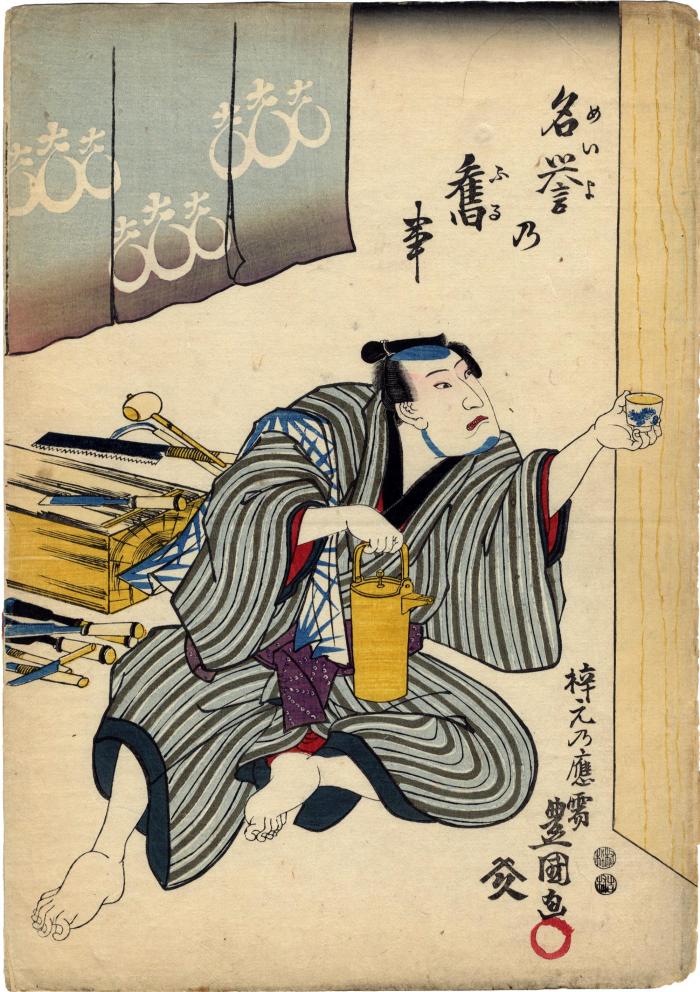Utagawa Kunisada (歌川国貞) / Toyokuni III (三代豊国) (artist 1786 – 01/12/1865)
Nakamura Utaemon IV as Hidari Jingorō from the triptych The Old Story of the Renowned Sculptor Hidari Jingorō (Sono mukashi Hidari Jingorō ga meiyo no furugoto - 其昔左甚五郎が名誉の旧事)
04/1847
10 in x 14 in (Overall dimensions) Japanese woodblock print
Signed: Hanmoto no ōju Toyokuni ga
梓元乃應需豊国画
Artist's seal: toshidama
Publisher: Yamamotoya Heikichi
(Marks 595 - seal 04-007)
Censor seals: Muramatsu and Yoshimura
Museum of Fine Arts, Boston - the full triptych
Waseda University
British Museum - the full triptych
Hankyu Culture Foundation
Waseda University - the center panel
Waseda University - right hand panel
Honolulu Museum of Art - the full triptych This image is from the play Toki no hina Asakusa hakkei performed at the Kawarazaki-za in 4/1847. This print is from the scene which is the grand finale. The playwright was Sakurada Jisuke III (1802-77).
****
There is the full triptych in the Victoria and Albert Museum, but it is no longer available online. The beginning of the title of the triptych is Sono mukashi Hidari Jingorō.... This can be translated as 'Once upon a time Hidari Jingorō...'.
****
The curatorial files at the British Museum say: "The kabuki actors (from left) Nakamura Utaemon IV as the sculptor Hidari Jingoro, Onoe Baiko IV as the life-size doll of a courtesan (‘Oyama ningyo’) emerging from a large wooden box, and Arashi Koroku V as Jingoro’s wife Otsuya, in the dance ‘Shiki no hina Asakusa hakkei’ (時翫雛浅草八景), (alternate reading ‘Toki no hina Asakusa hakkei’ , commonly called ‘Kyo ningyo’) (京人形), by Sakurada Jisuke III; performed at the Kawarasaki-za in the 4th month of 1847 (Koka 4)."
****
There was a real historical figure named Hidari Jingorō (左甚五郎). Some historians give a number of dates for his lifetime generally believed to have been 1594-1634. Laurence P. Roberts simply place him at the end of the Momoyama era to the beginning of the Tokugawa era. The name Hidari written with different characters means left-handed. There are lots of discussions as to what this means: was he left-handed and if so what does this mean?
****
In one of the versions of the Jingorō story he spots a gorgeous courtesan named Umegae in Kyoto. Some tell the story of the sculptor picking up and keeping the mirror the courtesan drop. Knowing that he can never have her he goes back to his workshop and carves a life-sized rendition which miraculously comes to life after he places the mirror in the folds of her robes. Similar in certain ways to the story of Pygmalion
In Japanese Dolls: the Fascinating World of Ningyo by Alan Scott Pate says on page 146: "In popular lore, the origins of ikiningyō [i.e., life-sized lifelike dolls] extended back well before Chūbei or Heijūrō to the life of the celebrated Momoyama-period Buddhist sculptor Hidari Jingorō, whose figures were so realistically carved that they often came to life... One of his most famous creations was a full-size figure of a bijin who came to life when Jingorō placed a mirror in the folds of her garment. Other stories tell of doll helpers that Jingorō carved from wood to assist him in completing a large project. Once he was finished, he tossed these iki-ningyō into the river where they transformed into the hungry kappa of legend which steal onto riverbanks at night and seize the hapless and unwary’... While contemporary iki-ningyō artists dominated the misemono stage, Jingorō and his adventures became popular subjects for woodblock print artists such as Utagawa Kuniyoshi (17971861) and Kawanabe Kyosai (1831-89) and for Kabuki performances as well."
Yamamotoya Heikichi (山本屋平吉) (publisher)
actor prints (yakusha-e - 役者絵) (genre)
Nakamura Utaemon IV (四代目中村歌右衛門: 1/1836-2/1852) (actor)
Hidari Jingorō (左甚五郎) (role)
